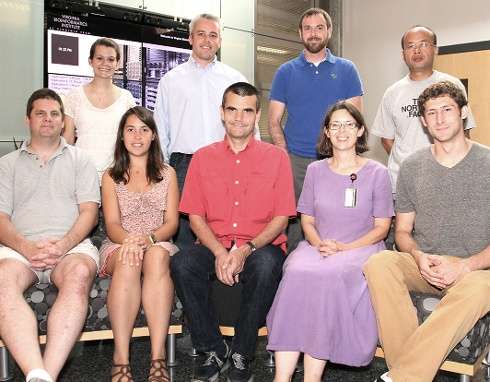Genetic languages guide the design of synthetic biological systems

(Phys.org) —Researchers at Virginia Tech and the Massachusetts Institute of Technology have used a computer-aided design tool to create genetic languages to guide the design of biological systems.
Known as GenoCAD, the open-source software was developed by researchers at the Virginia Bioinformatics Institute at Virginia Tech to help synthetic biologists capture biological rules to engineer organisms that produce useful products or health-care solutions from inexpensive, renewable materials.
GenoCAD helps researchers in the design of protein expression vectors, artificial gene networks, and other genetic constructs, essentially combining engineering approaches with biology.
Synthetic biologists have an increasingly large library of naturally derived and synthetic parts at their disposal to design and build living systems. These parts are the words of a DNA language and the "grammar" a set of design rules governing the language.
It has to be expressive enough to allow scientists to generate a broad range of constructs, but it has to be focused enough to limit the possibilities of designing faulty constructs.
MIT's Oliver Purcell, a postdoctoral associate, and Timothy Lu, an associate professor in the Department of Electrical Engineering and Computer Science, have developed a language detailed in ACS Synthetic Biology describing how to design a broad range of synthetic transcription factors for animals, plants, and other organisms with cells that contain a nucleus.
Meanwhile, Sakiko Okumoto, an assistant professor of plant pathology, physiology, and weed science at the Virginia Tech College of Agriculture and Life Sciences, and Amanda Wilson, a software engineer with the Synthetic Biology Group at the Virginia Bioinformatics Institute, developed a language describing design rules for expressing genes in the chloroplast of microalgae Their work was published in the Jan. 15 issue of Bioinformatics.
"Just like software engineers need different languages like HTML, SQL, or Java to develop different kinds of software applications, synthetic biologists need languages for different biological applications," said Jean Peccoud, an associate professor at the Virginia Bioinformatics Institute, and principal investigator of the GenoCAD project. "From its inception, we envisioned GenoCAD as a framework allowing users to capture their expertise of a particular domain in languages that they could use themselves or share with others."
The researchers said encapsulating current knowledge by defining standards will become increasingly important as the number and complexity of components engineered by synthetic biologists increases.
They propose that grammars are a first step toward the standardization of a broad range of synthetic genetic parts that could be combined to develop innovative products.
"Developing a grammar in GenoCAD is a little like writing a review paper," Purcell said. "You start with the headings and you progressively dig deeper in the details. At the end of the process, you have a much better appreciation for what you know and what you don't know about a particular domain."
Lu added, "Our group has a recognized expertise in synthetic transcription factors. We hope that this work will help a broad range of scientists use our results in their own projects."
"GenoCAD exemplifies the kind of cyberinfrastructure the institute is known for," said Dennis Dean, the director of the Virginia Bioinformatics Institute. "This type of portal can enable collaborations across disciplines and institutions to foster a team approach to today's most pressing scientific challenges."
More information: Mandy L. Wilson, Sakiko Okumoto, Laura Adam, and Jean Peccoud, "Development of a domain-specific genetic language to design Chlamydomonas reinhardtii expression vectors." Bioinformatics (2014) 30 (2): 251-257 first published online November 8, 2013 DOI: 10.1093/bioinformatics/btt646
Oliver Purcell, Jean Peccoud, and Timothy K. Lu. "Rule-Based Design of Synthetic Transcription Factors in Eukaryotes." ACS Synthetic Biology Article ASAP. DOI: 10.1021/sb400134k
Journal information: ACS Synthetic Biology , Bioinformatics
Provided by Virginia Tech


















